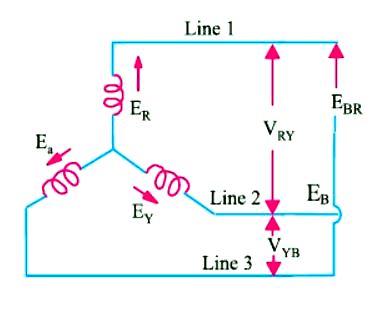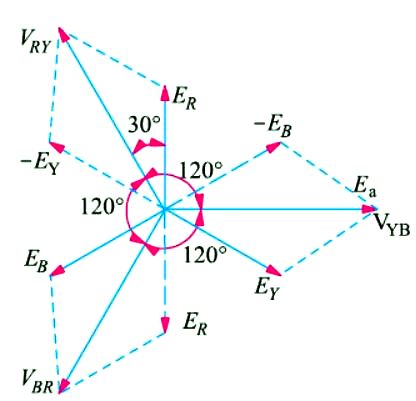Voltages and Currents in Star Connection
The Voltages and Currents in Star Connection has been explained in this article. The voltage induced in each winding is called the phase voltage and current in each winding is likewise known as phase current. However, the voltage available between any pair of terminals (or outers) is called line voltage (VL) and the current flowing in each line is called line current (IL).
As seen from Figure (A), in this form of interconnection, there are two phase windings between each pair of terminals but since their similar ends have been joined together, they are in opposition. Obviously, the instantaneous value of potential difference between any two terminals is the arithmetic difference of the two phase e.m.fs. concerned. However, the r.m.s. value of this potential difference is given by the vector difference of the two phase e.m.fs.
The vector diagram for phase voltages and currents in a star connection is shown in Figure (A) & (B).

(b) Where a balanced system has been assumed. It means that ER = EY = Eph (phase e.m.f.).
Line voltage VRY between line 1 and line 2 is the vector difference of ER and EY.
Line voltage VYB between line 2 and line 3 is the vector difference of EY and EB.
Line voltage VBR between line 3 and line 1 is the vector difference of EB and ER.
(a) Line Voltages and Phase Voltages
The p.d. between line 1 and 2 is VRY = ER – EY … vector difference.
Hence, VRY is found by compounding ER and EY reversed and its value is given by the diagonal of the parallelogram of Figure (C). Obviously, the angle between ER and EY reversed is 60°.
Hence if ER = EY = EB = say, Eph – the phase e.m.f., then
VRY =2 × Eph × cos(60°/2)

Similarly,
VYB = EY – EB = √3.Eph ………………………………vector difference
and VBR = EB – ER = √3.Eph
Now VRY = VYB – VRY = line voltage, VL. Hence, in
star connection VL = √3.Eph
It will be noted from Figure (C) that
1. Line voltages are 120° apart.
2. Line voltages are 30° ahead of their respective phase voltages.
3. The angle between the line currents and the corresponding line voltages is (30 + φ ) with current lagging.
AdBlock-2

(b) Line Currents and Phase Currents
It is seen from Figure (A) that each line is in series with its individual phase winding, hence the line current in each line is the same as the current in the phase winding to which the line is connected.
Current in line 1 = IR ; Current in line 2 = IY; Current in line 3 = IB
Since IR = IY = IB = say, Iph –————– the phase current
∴ line current IL = Iph

(c) Power
The total active or true power in the circuit is the sum of the three phase powers.
Hence,
total active power = 3 × phase power or
P = 3 × Vph Iph cos φ
Now Vph = VL /√3 and Iph = IL
Hence, in terms of line values, the above expression becomes

It should be particularly noted that φ is the angle between phase voltage and phase current and not between the line voltage and line current.
Similarly, total reactive power is given by
Q = √3VL IL sinφ
By convention, reactive power of a coil is taken as positive and that of a capacitor as negative.
The total apparent power of the three phases is
S = √3VL IL
![]()
Read article – potential difference
Visit NCERTplanet.com for NCERT solutions and Textbook downloads




